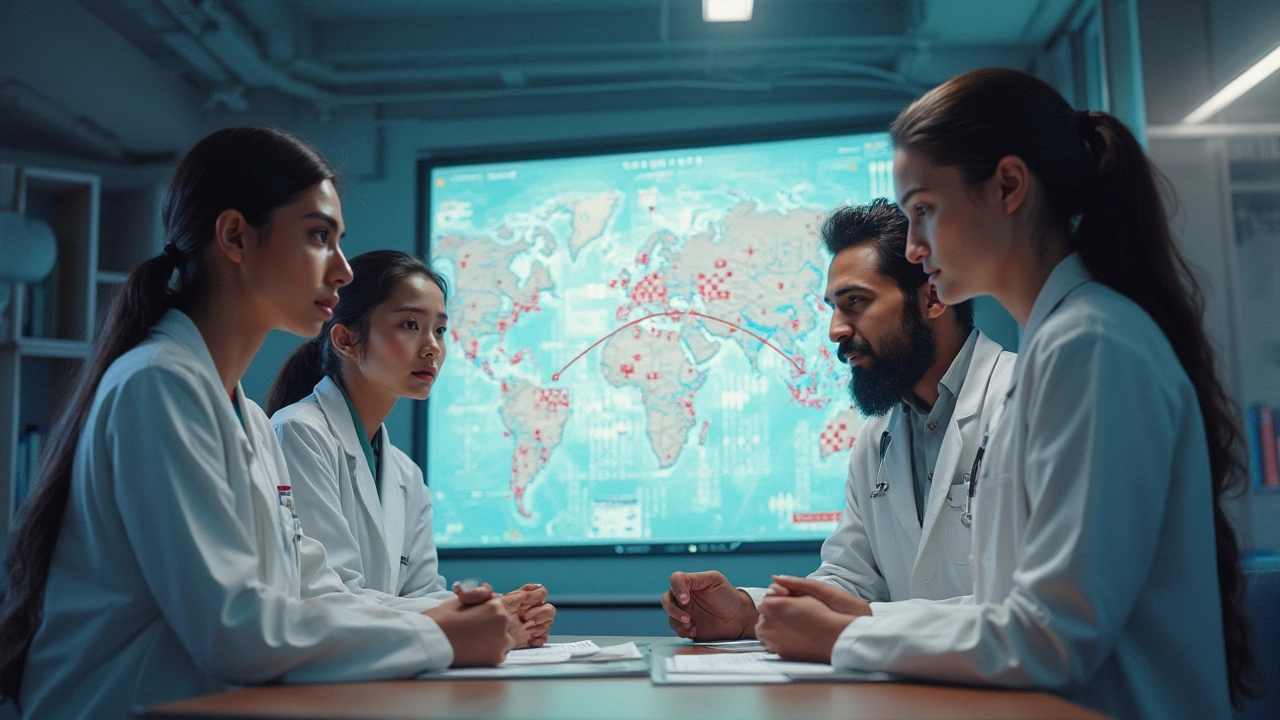Medical license exams aren’t just tough—they’re legendary for crushing even confident med school grads. These tests don’t just ask you to memorize bones or list symptoms. They want to know if you can actually think, solve weird real-life problems, and keep calm when you’re totally stumped.
If you’re staring down one of these beasts, it’s not just about studying hard. It’s a mental marathon. Doctors still have nightmares about their exam days, and it’s not rare to hear seasoned physicians say, ‘That was the hardest thing I ever did.’
So why are these exams so insane? It comes down to a mix of huge question banks, real-world scenarios where every detail could trip you up, and time limits that feel like a cruel joke. You need more than brainpower—you need grit, strategy, and a game plan that goes way beyond flashcards.
- What Makes a Medical License Exam So Brutal?
- USMLE: The Big Dog in Medical Exams
- Other Infamous Medical License Exams Around the World
- How to Prepare Without Losing Your Mind
What Makes a Medical License Exam So Brutal?
If you think all exams are the same, you haven’t met the medical license exam. These are a whole new league of difficult. Here’s what sets them apart from every test you’ve ever taken.
First, the sheer amount of content is wild. You’re expected to know everything from the tiny details of human anatomy to the complicated treatment plans for rare illnesses. It’s not just textbook facts, either. These exams dig deep into clinical reasoning—so you have to link symptoms, lab results, and patient histories to the right diagnosis, often while juggling several possible answers that all seem kind of correct.
Then there’s the format. Most licensing exams are massive. The USMLE Step 1, for example, goes on for 8 hours with over 280 questions. That’s basically a full workday slapped onto your brain, with barely a break to grab a snack. Even the structure is tricky: multiple choice questions hide traps in the options, and computer-based simulations test whether you panic under pressure.
- Stress is another beast. Passing isn’t just about pride—it’s what unlocks your whole career. No license, no practice. The failure rate can be surprisingly high, especially for international candidates.
- Time pressure is brutal. Most questions need quick thinking, not careful pondering. Seconds feel like they matter because, honestly, they do. One slow section can wreck your whole pace.
On top of that, these exams make you apply knowledge the way a real doctor would. Reading isn’t enough; you have to think like you’re alone in an ER and someone’s life depends on your answer. That’s why med students call these exams ‘gatekeepers’—they separate those who just memorize from those who can actually practice medicine.
USMLE: The Big Dog in Medical Exams
When people talk about the hardest medical license exam, they’re often pointing straight at the USMLE. That’s short for United States Medical Licensing Examination, and it’s pretty much the boss level for anyone wanting to treat patients in the U.S. It’s so tough, most med students start sweating about it on day one of school.
The USMLE is split into three parts—Step 1, Step 2 CK (Clinical Knowledge), and Step 3. Each step gets trickier and tests not just facts, but whether you can make real decisions when it matters. Step 1 is infamous for its monster question bank and for making or breaking residency dreams. In 2022, Step 1 moved to pass/fail, but don’t think that means it got easy—Step 2 CK scores now carry even more weight, and both steps are stress magnets.
The exam isn’t just about bubbling answers. It throws clinical scenarios at you—sometimes loaded with details you have to pick apart to find a diagnosis or a next step. You might spend hours on multiple-choice questions, then hit cases that look like real chart reviews. And time pressure? It’s relentless. Step 3 can stretch over two full days, with questions that start piling up when you’re already running low on energy.
One eye-opener: the average U.S. test-taker studies anywhere from 3 to 12 months, clocking hundreds of hours. Prep materials are almost an industry on their own, with famous names like UWorld and First Aid leading the pack. Everyone has a different method, but nobody breezes through it. Even top students talk about mental burnout and feeling nervous right up to test day.
- Know your weaknesses—mock exams give you a wake-up call about where you stand.
- Don’t just memorize—practice thinking like a doctor, breaking down tricky cases.
- Pace yourself—step away when you’re fried or you’ll burn out before exam week.
The truth is, the USMLE is designed to weed out those who aren’t ready for the crazy pace of real medicine. It’s not a paper-pushing test. It’s the gatekeeper for future doctors and rightfully feared by almost everyone who faces it.

Other Infamous Medical License Exams Around the World
The medical license exam scene isn’t just stressful in the US. Countries everywhere have their own dreaded tests, and some are so tough they’ve built a reputation that goes way beyond their borders. If you think you’ve heard it all with USMLE, wait till you see what doctors deal with elsewhere.
Let’s break down a few exams that make med students sweat in different corners of the globe:
- PLAB (UK): The Professional and Linguistic Assessments Board test is the UK’s gatekeeper for international docs. PLAB Part 1 is a big multiple-choice griller, but the real stress starts with Part 2—an OSCE (Objective Structured Clinical Examination) where candidates have to literally act out medical scenarios with actors. You get 18 stations and just eight minutes each. Drop your guard, and the actors will mess with you to see if you really know your stuff—not just book smarts, but the whole bedside-manner package.
- AIPGMEE / NEET-PG (India): India switched its postgrad medical entrance exam to NEET-PG, but earlier, AIPGMEE haunted a generation. With over 100,000 doctors battling for around 10,000 spots, it’s a dogfight. Questions jump from pathology to clinical vignettes faster than you can switch gears.
- MLE (Japan): Japan’s two-step process includes a written exam and a clinical skills test, all in Japanese medical lingo. It scares even native speakers. The pass rate for international candidates is often below 50%—making it a brick wall for outsiders.
- LEK (Poland): Poland’s Lekarski Egzamin Końcowy is taken right after graduation. It covers not just textbook questions, but also what you'd do with “real” patients. Most European countries now recognize the LEK, but you need a strong score to move on in Poland itself.
- AMC Exams (Australia): Australia’s process is a two-parter: a written exam with 150 questions in three and a half hours, and then a practical where you treat simulated patients in twelve short cases. The pass rate? About 35% for foreign graduates.
Here’s a look at how some of these tough exams stack up, based on pass rates and the number of test-takers per year:
| Exam | Country | Average Pass Rate | Test-Takers/Year |
|---|---|---|---|
| PLAB Part 2 | UK | 69% | ~8,000 |
| NEET-PG | India | ~45% | ~170,000 |
| MLE | Japan | 52% (Intl.) | ~3,000 |
| LEK | Poland | 92% | ~5,000 |
| AMC Clinical | Australia | 35% | ~2,500 |
Even the bravest, best-prepared med grads have crashed and burned in these exams. The main difference? Some systems, like NEET-PG, pit you against a massive crowd, while others like the AMC focus on grilling you one-on-one in practical stations. Either way, the stress is real—and there’s no shortcut but grinding through practice questions, mock exams, and (if you’re in Japan) maybe picking up a whole new language.
How to Prepare Without Losing Your Mind
Preparing for a medical license exam is a next-level stress test—mentally and physically. But with the right game plan, you can keep your sanity (mostly) intact and give yourself a real shot at passing.
Here’s what actually works—not just what you hear in horror stories:
- Lock Down a Study Schedule. Start early. For the USMLE Step 1, for example, most students spend 6-8 hours a day studying for two to four months. Set daily goals and stick to them, but build in real breaks. Burning out helps no one.
- Focus on Practice Questions. These exams love tricky, case-style questions. The more you expose yourself to them, the less you’ll freak out on test day. Question banks like UWorld or AMBOSS aren’t cheap, but they’re gold.
- Don’t Ignore Weak Spots. It’s tempting to keep reviewing stuff you’re already good at, but your score jumps the most when you shore up your weakest areas. Use practice test feedback to zero in on these.
- Review Like You Mean It. Cramming is a rookie mistake. Instead, use spaced repetition—apps like Anki work wonders for pumping facts into long-term memory without frying your brain.
- Get Real About Self-Care. Skip this part and you risk meltdown: eat real meals, sleep at least 7 hours, and move around every day. Even the best med student tanks if they’re running on empty.
You want some numbers? Here’s what recent data shows about successful study habits for USMLE Step 1:
| Study Habit | Average Pass Rate |
|---|---|
| Daily Practice Questions | 98% |
| Spaced Repetition Review | 95% |
| Less than 6 hours/night of sleep | 73% |
| Studied Over 6 Weeks | 97% |
One last tip: mock exams are painful, but taking two or three under real test conditions is a game-changer. They train your brain to handle long hours and fast thinking, which the actual license exam will demand in spades.
